
‘1984’ means different things to different people. For Google the the first 100 results are mainly about George Orwell’s novel, published in 1949 and set 35 years into the future largely in London in a post-nuclear war England which is in some respects rather chillingly close to what we now accept at normal.
Of course technology has advanced rather differently from that foreseen by Orwell, but we have come to take for granted something approaching the total surveillance, both from CCTV cameras in every shop and street and also through our willing participation in the internet and through the use of mobile phones and card-based payments. The tracking of our thoughts, movements and actions is less obvious than he envisaged but considerably more detailed, though largely carried out in the first instance by commercial organisations such as Google who monitor every click you make; though behind them sit the huge computers of GCHQ, sifting and analysing the whole of the internet. As you read this, Big Business as well as Big Brother is watching you!
But sinister though this sometimes seems, especially to some of my more tinfoil-hat wearing friends, it still represents more of a potential than an actual threat, used mainly to send us advertisements for things we have already bought.
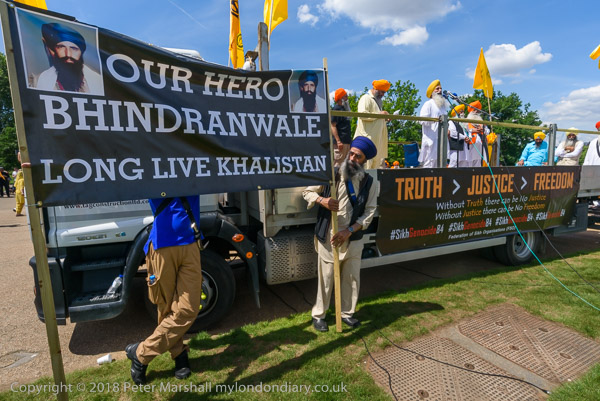
But for some people, 1984 has a different and far more sinister ring. Sikhs remember it as the year when India turned upon them, the Indian Army killing thousands attacking the Golden Temple complex and the Indian government spurring on mobs to continue the carnage after the assassination of Indira Ghandi at the end of October that year. The ‘Sikh Genocide’ which began at Amritsar was the second massacre in that city, the first being in 1919 when the British Indian Army opened fire on an peacefull protest in the Jallianwala Bagh Garden close to the Golden Temple, a key event in the rise of Indian nationalism that eventually led to independence and partition.
That partition of the Indian subcontinent by the colonial power at independence in 1947 was bound to result in a bad deal for the Sikhs, who were a small minority in the country and had no region in which they were a majority. They trusted the Indian National Congress and its promised more than those of the Muslims, but few of those promises were fulfilled. There are some problems for which there is no satisfactory solution and India in the 1940s was certainly one of them, though many would argue that better solutions could have been found. And given the current domination of India by Hindu nationalists, along with the long term problems of Pakistan, Bangladesh and Kashmir, it might be difficult to argue that Britain did much of a job back then.
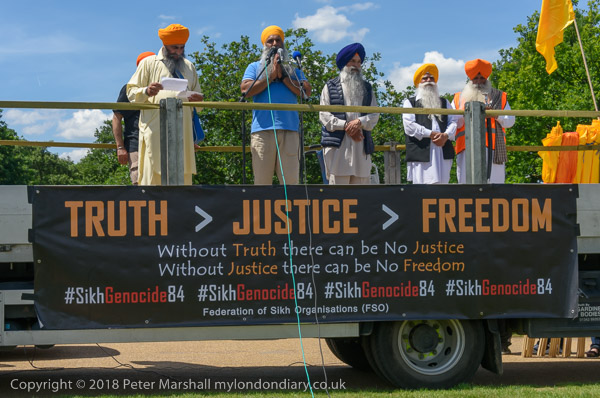
Though history is history and can’t be changed, it continues to reverberate, and the events of 1984 remain a vital issue for many Sikhs, including many who were not even born 34 years ago. This annual march has sometimes attracted the attention of the UK police, keen to crack down on the support for Babbar Khalsa, an international group which, according to Wikipedia, “wants to establish an independent country for Sikh religion called Khalistan, and uses bombings, kidnappings and murders to accomplish their goals” and is banned as a terrorist organisation in India, Canada, the EU, the UK, USA and Japan.
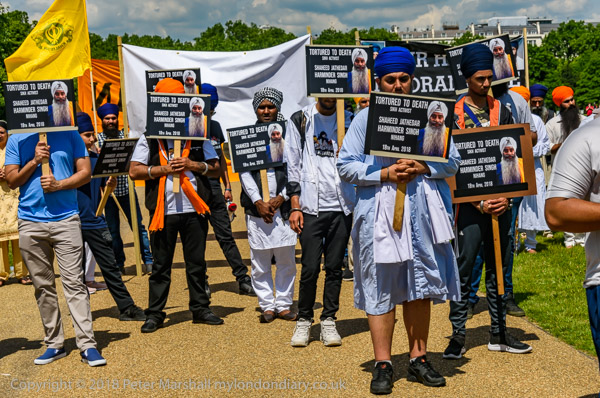
Of course many in the UK who support the foundation of Khalistan are against terrorism, and though there were speakers and banners calling for Khalistan this does not imply support for Babbar Khalsa and their activities in India or elsewhere.
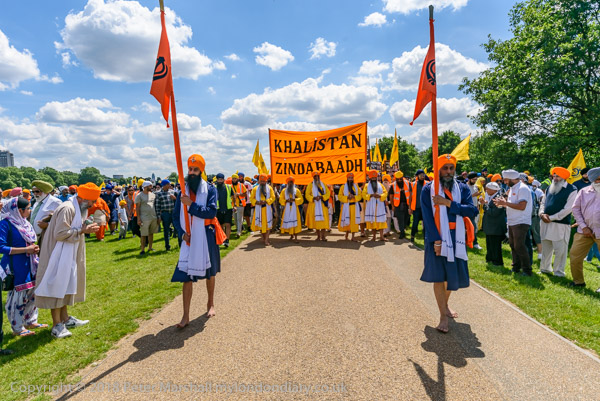
The march, with a large banner, ‘Khalistan Zindabaahd’, began by getting lost, failing to turn right as it left Hyde Park, led as usual by the standard bearers and ths five Khalsa with swords raised representing the ‘Five Blessed Ones’, who clearly had not been informed of the details of the route. The police who would normally have led them had not arrived to do so (those government cuts have meant much less policing of most protests) and the processsion ended up going around Marble Arch and then returning into Hyde Park to wait for the police to arrive and guide them. I think those leading the protest had come from Birmingham and were unfamiliar with the area.
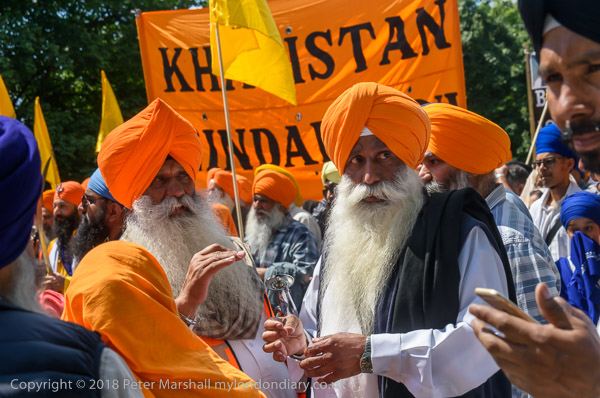
Eventually the march made a second start, going down Park Lane with the police in attendance, and I left them as they turned onto Piccadilly to march down towards Trafalgar Square for a rally.
______________________________________________________
There are no adverts on this site and it receives no sponsorship, and I like to keep it that way. But it does take a considerable amount of my time and thought, and if you enjoy reading it, a small donation – perhaps the cost of a beer – would be appreciated.
My London Diary : London Photos : Hull : River Lea/Lee Valley : London’s Industrial Heritage
All photographs on this and my other sites, unless otherwise stated, are taken by and copyright of Peter Marshall, and are available for reproduction or can be bought as prints.
To order prints or reproduce images
________________________________________________________